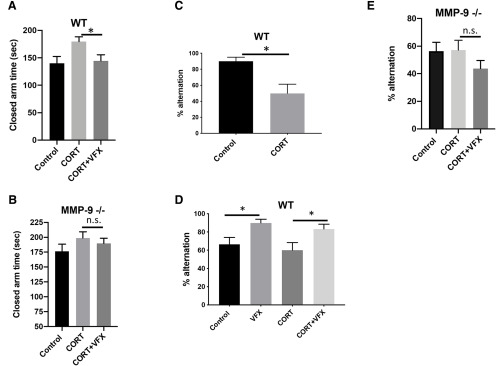Figure 7.
Reduced working memory in CORT-treated mice; rescue by VFX in WT mice. VFX reduced closed-arm time in CORT-treated animals tested with the EPM (A; n = 7-10 mice per group, p = 0.029, one-way ANOVA with Sidak's multiple comparisons testing). There was no significant difference between the CORT and CORT + VFX groups in MMP-9-null animals (B; n = 7-10 animals per group, p = 0.84, ANOVA with Tukey's multiple comparisons testing). C, We examined the effects of CORT on T-maze performance. CORT decreased working memory in WT mice (n = 10 mice per group, p = 0.0049, Student's t test). C, D, We also examined working memory in WT and MMP-9-null mice treated with CORT or CORT + VFX. VFX improved T-maze performance in CORT-treated control (n = 5 mice per group, p = 0.045, ANOVA with Sidak's multiple comparisons testing). In addition, VFX improved performance in animals that did not receive CORT (n = 5 mice per group, p = 0.045, ANOVA with Sidak's multiple comparisons testing). The difference between control and CORT groups was not significant in this cohort, which may be due to injection stress in both groups and/or a smaller n. In addition, although the WT controls in C and D showed differential performance, it should be noted that controls in D received stressful daily intraperitoneal saline, whereas controls in C received CD in their drinking water. E, T-maze results for MMP-9-null animals. We did not have a VFX only group for these animals. However, in contrast to WT animals, VFX did not improve performance in CORT-treated MMP-9-null mice (n = 7-10 animals per group, p = 0.36, ANOVA with Tukey's multiple comparisons testing). *p < 0.05, n.s., non significant.

